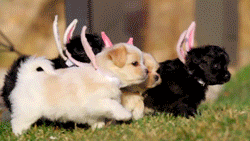There are easy, affordable, nontoxic alternatives for everything from egg dyes to Easter sweets.
Easter Egg Dye: Did you know that you can turn everything from red onions to frozen blueberries into natural dyes for Easter eggs? The Green Gifts Guide has a great assortment of natural dye recipes that you can make with white vinegar, water, and a wide variety of foods from your kitchen. For more food dye tutorials, check out this article from Yahoo Shine.
Easter baskets: Recycle baskets around the house, or check out the local thrift store for baskets, which you can wash, decorate, and transform into an easter basket. Simple Homemade recommends thinking outside the basket and using a beach pail, bonnet, or flower pot as a basket. If you’re feeling crafty, try one of these DIY basket ideas from Crafting a Green World.
Easter grass: Replace plastic easter grass with a more earth-friendly alternative. Try rafia, shredded recycled paper, recycled fabric or line the bottom of the basket with a soft gift, like a new piece of clothing.
Sweet Treats: When it comes to candy, the holidays are a time for over packaged, individually wrapped, themed sweets. Keep your edible Easter basket fillers eco-friendly by foregoing themed treats in favor of less packaging, organic options, and yummy DIY replacements.
- DIY: Save money and make your own Easter sweets by customizing candy and baked goods. Yahoo Shine has tips on how to turn lollipops into festive bunnies and flowers; you could also reduce the packaging by replacing the lollipop with bulk sweets packaged in a decorated recycled container. Or skip candy and try festive baked goods instead, like these gluten-free carrot muffins or one of healthy desserts on Healthy Child, Healthy World’s recipe database.
- Bulk candy: Minimize packaging and save money by skipping individually packaged items and stocking up on sweets from the bulk section at your supermarket.
- Candy shopping: In the market for organic candies? SheKnows has a top 10 list of organic sweets. You can also use this checklist on avoiding food additives from Healthy Child, Healthy World or look up candies on The Good Guide.
Toys: Many plastic toys contain phthalates, a toxic chemical linked to several health issues. Avoid phthalates by choosing cloth or wooden toys (and don’t forget to check out the tips below to help you pick the safest cloth and wooden toy options).
- Safer cloth toys: Look for cloth toys made out of organic cotton, wool, hemp, or bamboo. Read the labels, and stay away fabrics that are water repellant, water proof, or that are labelled “California TB 117.” The “California TB 117” label means that there are flame retardants in the item, which can be toxic, especially to children. For more information on flame retardants, and how to avoid them, visit the Green Science Policy Institute.
- Better wooden toys: Look for unvarnished wooden toys. If your purchase varnished toys, choose ones with a low-VOC or water-based stain or sealant, or toys that are finished with tung oil and beeswax
- Think outside the toy box: Lisa Frack from Environmental Working Group recommends skipping the non-toxic toy shopping hassle by switching out traditional toy gifts with fun activities. A meal at a favorite restaurant, a special day trip, or registration for a fun activity like ice skating or gymnastics all make great, non-toxic gifts. Books or art supplies can also make excellent basket fillers.




